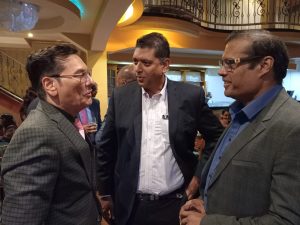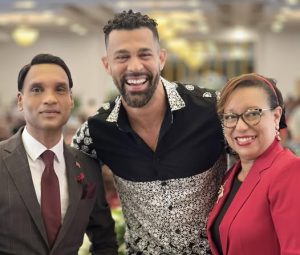IN the Caribbean more men than women tend to be involved in sporting activities. Sports have become one of the most important factors in defining and influencing Caribbean masculinities in the 20th and 21st century.
For more than a century, cricket, rugby and football (soccer) have been manifestations of masculinity.
Boys aspiring to be men, seek the avenue of cricket and/or football to earn the admiration of peers and gain the approval of society. In most countries cricket or football remains one of the forces shaping the macho image. The exploits and influence of past and present football stars are critical in understanding the inner desire and determination of Latin American and Caribbean men to enter sports and aspire for financial success and fame.
As in other regions, the Caribbean and Latin America has a considerable list of ‘marginalised sports.’ Games such as boxing, weightlifting, karate, volleyball, rugby, swimming, tennis, and horseracing often compete with football and cricket for financial resources and more importantly– the attention of the public.
Interestingly, the duration and level of activity of certain sports often determine the status of that particular sport among men. An illustration is football, a game lasting ninety minutes in comparison to cricket which can last between one and five days. It can be argued that geographical factors need to be considered, for example, in South America, football has the potential to generate a considerable amount of enthusiasm.
Likewise, in India or Pakistan the game of cricket is the heart and soul of most of its citizens.
The unknowing promotion of such stereotypes has hinged on the participation of men certain sports. For instance, in the English-speaking Caribbean, netball and aerobics have been seen as appealing to women.
However, an interesting development in recent years has been the increasing involvement of men in these two sporting areas.

Additionally, both sexes participate, though to a limited extent, in Taekwondo and marathons. The ultimate test in endurance and perseverance- the marathon, remains one of the bastions of gender equality that has not as yet been eroded by sporting stereotypes.
Sports also possess the potential to create divisions among men. For instance, men possessing the necessary money and time are usually involved in golf which is usually associated with a certain social status and class.
In the Caribbean and Latin American region, this game is usually associated with persons in the upper middle class or upper class lifestyle. The costs of membership, equipment, special diets and rigorous training are restrictions which allow only a few privileged persons access to certain sports. In the poorer countries, the cost of competing at the regional and international levels coupled with self-discipline often result in sports remaining as a hobby, a form of relaxation or even an outlet for frustration for the working class.
The dream of becoming a rich and famous sporting star eludes many due to the uncertainties surrounding a career in sports. Poor performance or injuries are factors which prematurely end the promising careers of young sportsmen. The reality of an early retirement in sports results in a dilemma, especially among breadwinners in a large family. Such a problem will lead to either subtle apathy for the particular sport or an eventual eclipsing of sport from its association with masculinity. Not surprisingly, negative publicity as the doping scandals in athletics and match-fixing allegations in cricket has not impacted on the support and interest among men.
Undoubtedly, the strong emphasis on primary and secondary education rather than sports results in increased competition for well-paid jobs. This would contribute to the decision to participate at the national level rather than becoming a professional.
The result has been an increase of local clubs and neighbourhood games throughout the West Indian islands and Latin America.
Indeed, the involvement of males in sporting activities and acceptance by supporters have become a yardstick to measure and determine the macho appeal which will influence another generation. The emergence of new sports and new techniques to improve the level of playing will impact on re-defining masculinity. The relationship between the passion of the fans and the players has created a unique space which will continue to exist beyond the 21st century.
Dr Jerome Teelucksingh is an activist. He initiated the inaugural observances of International Day for the Elimination of Violence Against Men and Boys (January 31) and World Day of the Boy Child (May 16). He has made academic presentations at tertiary institutions including Harvard University and Oxford University.
See other articles by Dr Jerome Teelucksingh on AZP News:
An Indo-Trinidadian Doctor in Toronto
Canadian and Missionaries and Education
Evolution of Education and Presbyterianism
An Early History of Naparima College
The Glorious City of Port of Spain
Have we Forgotten George Padmore
Nobody Cares about Underachievement
Can we Eradicate Underachievement?
A Quiet Pandemic: Male Underachievement
The Blackest Thing in Slavery wasn’t Slaves
The Importance of Emancipation Day
Tobago’s Working Class in the 1920s, 1930s
Are Humble Caring Fathers Champions?
Influencing West Indian Masculinity
Defining Caribbean Masculinity
Is Monogamy Encouraged in the Caribbean
Naps Girls: From Humble Beginnings to Excellence
US Media Creates Cultural Dependency in the Caribbean
Bloodless Revolution to Save Lives in Developing Countries
The Need for a Social and Moral Revolution
The Law of Supply and Demand in Developing Countries
End the Dependency for Developing Countries
T&T Carnival and the Emperor’s New Clothes
The Influence of Labour on Caribbean Integration
The illusion of political Unity
Presbyterians in Trinidad: Humble Missionaries, Local Workers
Religious Plurality: Curse or Blessing
Caribbean Youth Need Optimism, Patriotism
Rethinking Identities in Caribbean, Latin America
November 19: All Inclusive International Men’s Day
Should International Agencies be Blamed for Unemployment
A Need to Observe Word Unemployment Day
An Ideology for the Trade Union Movement
The Man who Couldn’t be Prime Minister
Social Outburst vs Social Revolution
Challenges of the Men’s Movement
If George Floyd was Denied Parole
The Meaning of Indian Arrival Day in T&T
International Men’s Day – A Way of Life
Wounds that cause school violence
May Day: A Time for Solidarity, Strength
Who Coined the Term ‘Black Power’
The illusion of political Unity
Presbyterians in Trinidad: Humble Missionaries, Local Workers
Religious Plurality: Curse or Blessing
Caribbean Youth Need Optimism, Patriotism
Rethinking Identities in Caribbean, Latin America
November 19: All Inclusive International Men’s Day
Should International Agencies be Blamed for Unemployment
A Need to Observe Word Unemployment Day
An Ideology for the Trade Union Movement
The Man who Couldn’t be Prime Minister
Social Outburst vs Social Revolution
Challenges of the Men’s Movement
If George Floyd was Denied Parole
The Meaning of Indian Arrival Day in T&T
International Men’s Day – A Way of Life
Wounds that cause school violence
May Day: A Time for Solidarity, Strength
Who Coined the Term ‘Black Power’
![]()














